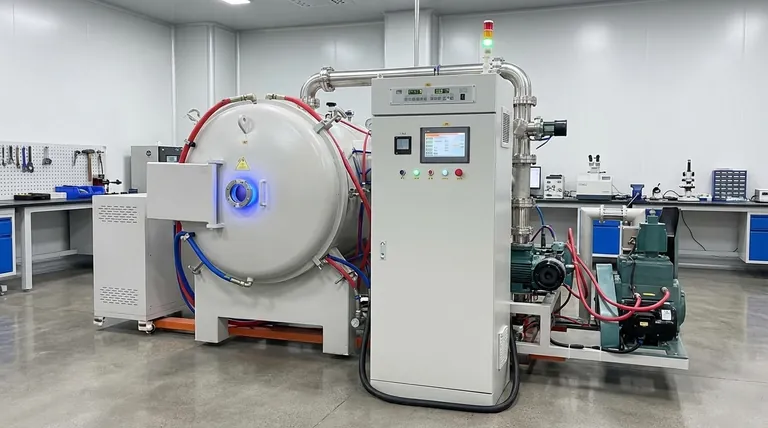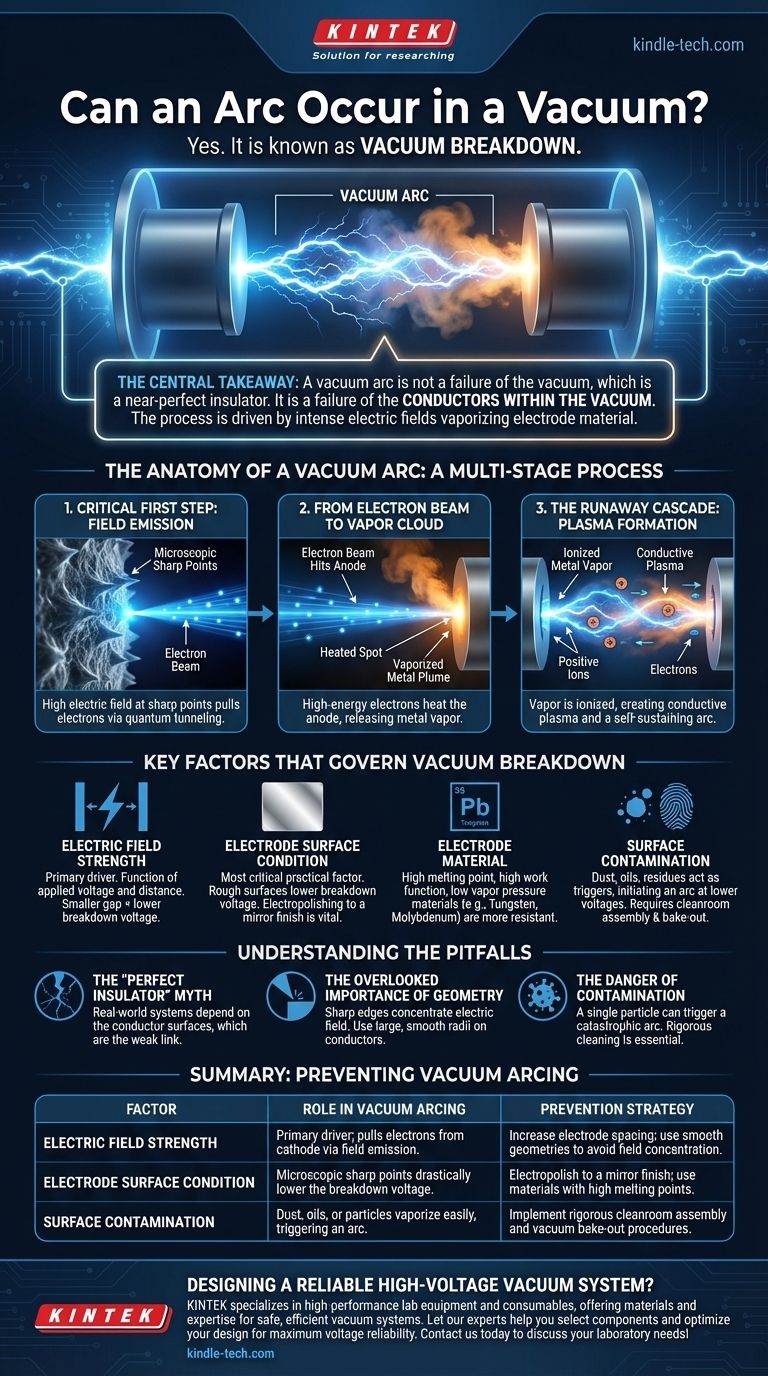일반적인 직관과는 달리, 전기 아크는 진공 상태에서도 분명히 발생할 수 있습니다. 이 현상은 진공 절연 파괴(vacuum breakdown)라고 알려져 있으며, 공기 중의 아크와는 근본적으로 다릅니다. 주변 가스가 절연 파괴되는 대신, 높은 전기장이 전극 재료 자체를 아크의 원천으로 만들고, 기화된 금속의 전도성 채널을 생성합니다.
핵심 요점은 진공 아크가 거의 완벽한 절연체인 진공의 실패가 아니라는 것입니다. 그것은 진공 내의 도체의 실패입니다. 전체 과정은 전기장이 너무 강해져서 전극 표면에서 직접 전자를 찢어내고 재료를 기화시켜 아크를 형성하는 데 필요한 매개체를 만드는 방식으로 진행됩니다.

진공 아크의 해부학
진공 아크를 방지하는 방법을 이해하려면 먼저 진공 아크의 뚜렷한 수명 주기를 이해해야 합니다. 이는 전극이 자체 "연료"를 제공하는 다단계 과정입니다.
결정적인 첫 단계: 전계 방출
이 과정은 음극(캐소드)의 표면에서 시작됩니다. 아무리 잘 연마된 표면이라도 미세한 날카로운 점이나 "수염"이 존재합니다.
높은 전기장은 이 작은 지점에 집중됩니다. 전기장이 충분히 강하면(제곱미터당 수백만 볼트), 파울러-노르트하임 터널링(Fowler-Nordheim tunneling)이라는 양자 역학적 효과를 통해 금속 표면에서 직접 전자를 끌어낼 수 있습니다.
전자 빔에서 증기 구름으로
이렇게 방출된 전자들은 고전압에 의해 진공 갭을 가로질러 가속되어, 밀집된 빔을 형성합니다.
이 고에너지 전자 빔은 양극(애노드)에 부딪혀 작은 지점을 빠르게 가열합니다. 에너지가 충분하면 이 지점은 끓는점까지 가열되어 기화된 금속의 연기 기둥을 진공 갭으로 방출합니다.
폭주하는 연쇄 반응: 플라즈마 형성
새롭게 생성된 금속 증기 구름은 누락된 성분입니다. 이제 전계 방출된 전자는 이 금속 원자들과 충돌하여 이온화시킬 수 있습니다.
이 이온화는 전도성 플라즈마를 생성합니다. 이는 양이온 금속 이온과 더 많은 자유 전자의 혼합물입니다. 양이온은 캐소드 쪽으로 다시 가속되어 캐소드에 부딪히고 더 많은 가열, 스퍼터링 및 훨씬 더 많은 전자의 방출을 유발합니다. 이는 우리가 밝은 아크로 보는 자가 유지되는 폭주 연쇄 반응을 생성합니다.
진공 절연 파괴를 지배하는 주요 요인
절연 파괴 전압이 상당히 예측 가능한 공기와는 달리, 진공 절연 파괴는 시스템의 상태와 준비에 크게 의존합니다.
전기장 강도
이것이 주요 원동력입니다. 이는 인가 전압과 전극 사이의 거리 모두의 함수입니다. 더 작은 갭은 동일한 임계 전기장 강도를 달성하기 위해 더 낮은 전압을 필요로 합니다.
전극 표면 상태
이것은 아마도 가장 중요한 실제적인 요소일 것입니다. 거칠고 연마되지 않거나 가공된 표면은 미세한 날카로운 점들로 덮여 있어 전계 방출을 시작하는 데 필요한 전압을 극적으로 낮춥니다. 이것이 고전압 진공용 부품이 종종 거울처럼 매끄럽게 전해 연마되는 이유입니다.
전극 재료
금속의 선택이 중요합니다. 융점이 높고, 일함수가 높으며, 증기압이 낮은 재료(예: 텅스텐 또는 몰리브덴)는 알루미늄이나 구리와 같은 재료보다 아크 발생에 더 강합니다.
표면 오염
먼지 입자, 지문에서 나온 기름, 잔류 세척 용매와 같은 모든 이물질은 전자에 부딪히면 쉽게 기화될 수 있습니다. 이러한 오염 물질은 "방아쇠" 역할을 하여 깨끗한 전극 재료가 허용하는 것보다 훨씬 낮은 전압에서 아크를 시작합니다.
함정 이해하기
진공 상태에서 고전압을 위한 설계를 하려면 가스의 특성에서 벗어나 극한의 스트레스 하에 있는 고체 재료의 특성으로 사고방식을 전환해야 합니다.
"완벽한 절연체" 신화
완벽한 진공은 완벽한 절연체이지만, 실제 시스템은 그렇지 않습니다. 시스템의 절연은 내부 도체의 표면만큼만 좋습니다. 전극은 항상 약한 고리입니다.
간과된 기하학의 중요성
엔지니어는 부품의 기하학에 집착해야 합니다. 도체의 날카로운 모서리나 각진 부분은 전기장을 집중시켜 전계 방출의 잠재적 장소가 됩니다. 모든 고전압 도체는 크고 매끄러운 곡률을 가져야 합니다.
오염의 위험
대기 시스템에서는 약간의 먼지가 무해할 수 있습니다. 고전압 진공 시스템에서는 단 하나의 미세 입자가 치명적인 아크의 씨앗이 될 수 있습니다. 이것이 엄격한 클린룸 조립과 진공 베이크아웃 절차(오염 물질을 제거하기 위해 진공 상태에서 시스템을 가열하는 것)가 표준 관행인 이유입니다.
설계에서 진공 아크를 방지하는 방법
절연 파괴를 방지하기 위한 전략은 시스템의 주요 요구 사항에 직접적으로 달려 있습니다.
- 전압 신뢰성을 극대화하는 것이 주된 목표라면: 전극 재료 선택(예: 텅스텐 또는 스테인리스 스틸)과 미세한 날카로운 점을 제거하기 위한 전해 연마를 포함한 세심한 표면 준비를 우선시하십시오.
- 실용적인 시스템을 설계하는 것이 주된 목표라면: 모든 도체에 크고 매끄러운 곡률을 사용하고 전체 전기장을 낮추기 위해 이론적인 최소값보다 충분히 넓은 간격을 확보하여 부품의 기하학에 집중하십시오.
- 장기적인 작동 안정성이 주된 목표라면: 시스템을 밀봉하거나 작동하기 전에 모든 표면 오염 물질과 흡착된 가스를 제거하기 위해 엄격한 세척 및 진공 베이크아웃 절차를 구현하십시오.
궁극적으로 진공 아크의 위험을 관리하는 것은 진공 자체를 제어하는 것이 아니라 진공 내의 표면을 제어하는 것입니다.
요약표:
| 요인 | 진공 아크 발생에서의 역할 | 예방 전략 |
|---|---|---|
| 전기장 강도 | 주요 원동력; 전계 방출을 통해 캐소드에서 전자를 끌어냅니다. | 전극 간격 늘리기; 전기장 집중을 피하기 위해 매끄러운 기하학적 구조 사용. |
| 전극 표면 상태 | 미세한 날카로운 점들이 절연 파괴 전압을 극적으로 낮춥니다. | 거울처럼 매끄럽게 전해 연마; 융점이 높은 재료 사용. |
| 표면 오염 | 먼지, 기름 또는 입자가 쉽게 기화되어 아크를 유발합니다. | 엄격한 클린룸 조립 및 진공 베이크아웃 절차 구현. |
신뢰할 수 있는 고전압 진공 시스템을 설계하고 계신가요?
진공 아크를 방지하려면 전극 재료, 표면 마감 및 조립 청결도에 대한 정밀한 제어가 필요합니다. KINTEK은 고성능 실험실 장비 및 소모품을 전문으로 하며, 귀사의 진공 시스템이 안전하고 효율적으로 작동하도록 보장하는 재료와 전문 지식을 제공합니다.
저희 전문가들이 귀하의 특정 실험실 요구 사항에 맞는 구성 요소를 선택하고 최대 전압 신뢰성을 위해 설계를 최적화하도록 도와드리겠습니다. 지금 문의하세요!
시각적 가이드




















